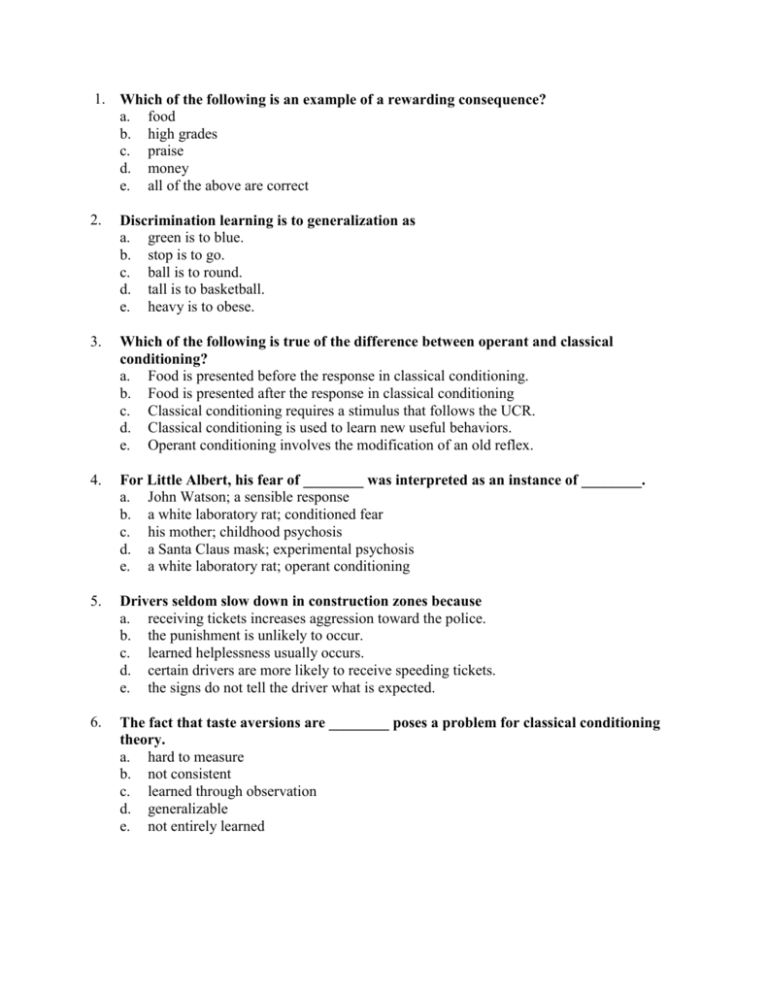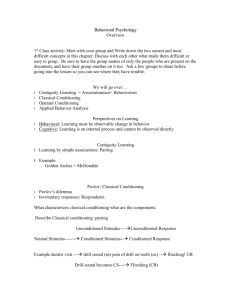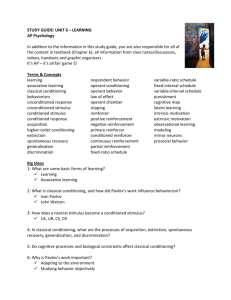Is Whereas The headache Is
advertisement

1. Which of the following is an example of a rewarding consequence? a. food b. high grades c. praise d. money e. all of the above are correct 2. Discrimination learning is to generalization as a. green is to blue. b. stop is to go. c. ball is to round. d. tall is to basketball. e. heavy is to obese. 3. Which of the following is true of the difference between operant and classical conditioning? a. Food is presented before the response in classical conditioning. b. Food is presented after the response in classical conditioning c. Classical conditioning requires a stimulus that follows the UCR. d. Classical conditioning is used to learn new useful behaviors. e. Operant conditioning involves the modification of an old reflex. 4. For Little Albert, his fear of ________ was interpreted as an instance of ________. a. John Watson; a sensible response b. a white laboratory rat; conditioned fear c. his mother; childhood psychosis d. a Santa Claus mask; experimental psychosis e. a white laboratory rat; operant conditioning 5. Drivers seldom slow down in construction zones because a. receiving tickets increases aggression toward the police. b. the punishment is unlikely to occur. c. learned helplessness usually occurs. d. certain drivers are more likely to receive speeding tickets. e. the signs do not tell the driver what is expected. 6. The fact that taste aversions are ________ poses a problem for classical conditioning theory. a. hard to measure b. not consistent c. learned through observation d. generalizable e. not entirely learned 7. According to Skinner, when you take an aspirin for your headache, taking the aspirin is ________ whereas the headache is ________. a. a positive reinforcer; an operant b. an operant; a negative reinforcer c. an operant; a positive reinforcer d. a negative reinforcer; an operant e. an operant; negative punishment 8. The most effective form of punishment usually involves a. intense physical pain. b. penalties, such as loss of privileges. c. psychological pain. d. attacks on character. e. delayed and inconsistent consequences. 9. Your friend works in a lab and is paid for each blood smear analyzed. Your friend is operating on which schedule of reinforcement? a. fixed ratio b. variable ratio c. fixed interval d. variable interval e. random interval 10. Your professor likes to give pop quizzes in your psychology class, thus she is promoting the ________ schedule of reinforcement. a. fixed ratio b. variable ratio c. fixed interval d. variable interval e. continuous 11. The notion that learning produces physical changes in the synapses of the brain is consistent with a. hemispheric lateralization. b. brain imaging. c. spatial mapping. d. long-term potentiation. e. myelinization of neurons. 12. The key difference between the two main forms of schedules of reinforcement is whether a. reinforcers are given or removed. b. reinforcement occurs often or rarely. c. the behaviors will increase or decrease in frequency. d. a person can control the consequences of the reinforcement. e. reinforcement is determined by time or by number of responses. 13. B.F. Skinner was a radical behaviorist who refused to a. conduct research with animals other than humans. b. believe that observation tells us anything about human nature. c. understand how it was possible for people to change. d. accept that individuals can change over time. e. speculate about what happens inside an organism. 14. Which of the following would NOT be an example of learning? a. A newborn infant sucks on a nipple filled with milk. b. A teenager falls asleep after staying awake for 96 hours. c. A rat presses a lever to obtain a food pellet. d. You wince when you see a long needle similar to the one that hurt you during a drug injection last week. e. A and B are correct. 15. Jane's dog will listen to her commands but ignores her sister's commands. Jane's dog would be demonstrating a. spontaneous recovery. b. social learning. c. insight learning. d. stimulus discrimination. e. stimulus generalization. 16. Gina walks into her psychology class on the first day, and she sits next to Roger. She thinks his looks are decent, but by the end of the semester she finds him to be quite attractive due to a. the mere exposure effect. b. habituation. c. continuous reinforcement. d. shaping. e. her new cognitive map. 17. Thorndike's idea that responses that brought about positive outcomes would likely be repeated is called a. the law of Skinner. b. the law of affect. c. the law of direct. d. the law of protect. e. the law of effect. 18. Which of the following is NOT a key difference between operant and classical conditioning? a. the order of stimulus and response b. whether they are voluntary c. whether they are based on reflex responses d. whether behavior is based on past stimulation or future conditions e. whether they attempt to explain how learning occurs 19. The longest interval between the CS and UCS is required for classical conditioning of a. motor responses. b. visceral responses. c. conditioned salivation. d. conditioned fear. e. reflex responses. 20. The best way to ensure that your son will continue to clean his room once he has started doing it is to a. reward him some, but not all, of the times he cleans his room. b. reward him every time he cleans his room. c. reward him with money or new video games. d. punish him every time he fails to clean his room. e. never reward him other than to expect him to gain his own personal benefits from cleaning his room. 21. In the Pavlov study, the salivation to the tone represents the _____________________ after conditioning. a. unconditioned stimulus (UCS) b. orienting response (OR) c. conditioned stimulus (CS) d. conditioned response (CR) e. neutral stimulus (NS) 22. ________ are consequences that alter the likelihood of behaviors. a. Conditioned and unconditioned reflexes b. Successive approximations c. Rewards and punishments d. Conditioned and unconditioned stimuli e. Discrimination and generalization 23. Insight learning involves a. the perception of familiar objects in new forms or relationships. b. the integration of unfamiliar objects into familiar patterns. c. a strategy of vicarious trial-and-error. d. the development of abstract concepts. e. the process of assimilation. 24. Negative reinforcement involves a. the learning of a new response. b. the removal of an aversive stimulus. c. decreasing the likelihood of certain future behaviors. d. providing an unpleasant stimulus periodically during the day. e. pairing an old reflex with a new stimulus. 25. Studies of observational learning demonstrate that a. nonhuman species cannot learn by imitation. b. learning can occur in the absence of personal experience. c. television viewing has more influence on behavior than direct observation of live events. d. people learn antisocial behaviors (but not prosocial behaviors) through observation. e. reward has a greater influence on our behavior than does punishment. 26. As discrimination tasks with unpleasant stimuli become increasingly more difficult we can expect a. better learning to occur due to generalization. b. agitation due to experimental neurosis. c. extinction due to extreme confusion. d. appetitive conditioning due to shaping. e. intermittent reinforcement due to prompting. 27. Positive reinforcers ________ the likelihood of ensuing responses. a. decrease b. increase c. extinguish d. eliminate e. have no effect on 28. Damage to neurons within the ________ that use the transmitter ________ would be expected to diminish the experience of reward. a. limbic system; dopamine b. cerebellum; GABA c. parietal cortex; epinephrine d. medulla; serotonin e. cerebrum; acetylcholine 29. The linkage between a UCS and the UCR requires a. that the person must be hungry. b. the individual must receive either punishment or reinforcement. c. a critical impact of insight. d. no learning. e. that the dog salivates at the sound of the bell. 30. ________ reported that watching violent behaviors makes children more likely to behave violently? a. Watson b. Thorndike c. Tolman d. Bandura e. Garcia 31. Which of these punishments is LEAST likely to be effective? a. Claire is punished immediately for swearing at her mother. b. Dylan does not get desert every time he fails to clear the dinner table. c. To punish Brenda for hitting, her parents take away her phone but do not spank her. d. Brandon's parents call him a liar when he is dishonest. e. B and C are correct. 32. An eye blink is an example of a. introspection. b. an environmental event. c. a reflex. d. an operant. e. shaping. 33. ________ is a procedure for changing behavior by reinforcing responses that approach the desired goal. a. Molding b. Shaping c. Natural selection d. Behavioral analysis e. Counterconditioning 34. Which of the following is NOT an example of an operant? a. A dog salivates after seeing a bowl of meat. b. One-month-old Jamie sucks on a nipple in order to hear her mother's voice. c. A rat presses a lever to receive a food pellet. d. Sam tells a joke that has previously evoked much laughter. e. Abe repeatedly presses a button on a toy, because he likes the loud sound it makes. 35. During summer camp, campers get a sticker each time they demonstrate good sportsmanship. When they have earned 10 stickers, they may select a candy bar. This represents an example of a. negative reinforcement. b. primary shaping. c. classical conditioning. d. reward generalization. e. a token economy. 36. If you salivate to the smell of a hamburger and fries, learning theory would suggest that you have formed an association based on a. classical conditioning. b. hunger messages from the cortex. c. stimulus generalization. d. olfactory hallucinations. e. operant conditioning. 37. In terms of the equity of punishment, a. girls are punished more often than boys. b. punishment is usually applied equally to all people. c. schools more often use punishment to control members of racial minority groups. d. boys and girls receive about equal amounts of punishment. e. grade school children receive as much physical punishment as do adults. 38. The Premack principle states that a. a preferred activity can be used to reinforce a less preferred one. b. in order to be effective, reinforcement must be unpredictable. c. reinforcement is more effective than punishment. d. punishment must be used consistently and immediately. e. using two types of punishment works better than using only one. 39. The two main types of behavioral learning are a. reflexive responses and shaping. b. insight learning and operant conditioning. c. classical conditioning and operant conditioning. d. social learning and observational learning. e. reinforcement and insight learning. 40. A(n) ________ refers to the behavior elicited by the unconditioned stimulus. a. conditioned stimulus b. conditioned response c. unconditioned response d. controlled response e. neutral response Test Name: reviewchp3zim 1. e. all of the above are correct 2. b. stop is to go. 3. a. Food is presented before the response in classical conditioning. 4. b. a white laboratory rat; conditioned fear 5. b. the punishment is unlikely to occur. 6. e. not entirely learned 7. b. an operant; a negative reinforcer 8. b. penalties, such as loss of privileges. 9. a. fixed ratio 10. d. variable interval 11. d. long-term potentiation. 12. e. reinforcement is determined by time or by number of responses. 13. e. speculate about what happens inside an organism. 14. e. A and B are correct. 15. d. stimulus discrimination. 16. a. the mere exposure effect. 17. e. the law of effect. 18. e. whether they attempt to explain how learning occurs 19. d. conditioned fear. 20. a. reward him some, but not all, of the times he cleans his room. 21. d. conditioned response (CR) 22. c. Rewards and punishments 23. a. the perception of familiar objects in new forms or relationships. 24. b. the removal of an aversive stimulus. 25. b. learning can occur in the absence of personal experience. 26. b. agitation due to experimental neurosis. 27. b. increase 28. a. limbic system; dopamine 29. d. no learning. 30. d. Bandura 31. d. Brandon's parents call him a liar when he is dishonest. 32. c. a reflex. 33. b. Shaping 34. a. A dog salivates after seeing a bowl of meat. 35. e. a token economy. 36. a. classical conditioning. 37. c. schools more often use punishment to control members of racial minority groups. 38. a. a preferred activity can be used to reinforce a less preferred one. 39. c. classical conditioning and operant conditioning. 40. c. unconditioned response









